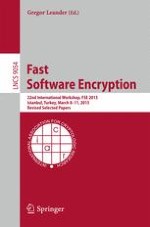2015 | OriginalPaper | Buchkapitel
Relaxing Full-Codebook Security: A Refined Analysis of Key-Length Extension Schemes
verfasst von : Peter Gaži, Jooyoung Lee, Yannick Seurin, John Steinberger, Stefano Tessaro
Erschienen in: Fast Software Encryption
Verlag: Springer Berlin Heidelberg
Aktivieren Sie unsere intelligente Suche, um passende Fachinhalte oder Patente zu finden.
Wählen Sie Textabschnitte aus um mit Künstlicher Intelligenz passenden Patente zu finden. powered by
Markieren Sie Textabschnitte, um KI-gestützt weitere passende Inhalte zu finden. powered by
Abstract
-
Plain cascades of length \(\ell =2r+1\) are secure whenever \(q_cq_e^r \ll 2^{r(\kappa +n)}\), \(q_c \ll 2^\kappa \) and \(q_e \ll 2^{2\kappa }\). The bound for \(r = 1\) also applies to two-key triple encryption (as used within Triple DES).
-
The r-round XOR-cascade is secure as long as \(q_cq_e^r \ll 2^{r(\kappa +n)}\), matching an attack by Gaži (CRYPTO 2013).
-
We fully characterize the security of Gaži and Tessaro’s two-call \(\mathsf {2XOR}\) construction (EUROCRYPT 2012) for all values of \(q_c\), and note that the addition of a third whitening step strictly increases security for \(2^{n/4} \le q_c \le 2^{3/4n}\). We also propose a variant of this construction without re-keying and achieving comparable security levels.
